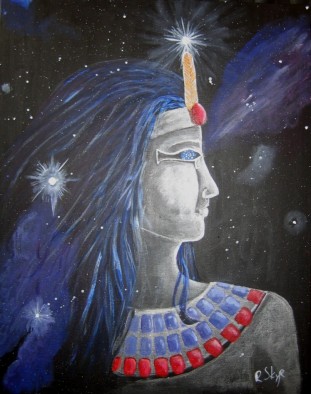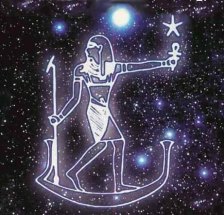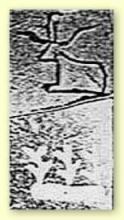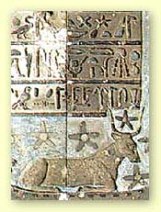“Sopdet’s themes are fertility, destiny and time. Her symbols are stars and dogs. The reigning Egyptian Queen of the Constellations, Sopdet lives in Sirius, guiding the heavens and thereby human destiny. Sopdet is the foundation around which the Egyptian calendar system revolved, Her star’s appearance heralding the beginning of the fertile season. Some scholars believe that the Star card of the Tarot is fashioned after this Goddess and Her attributes.
The long, hot days of summer are known as the ‘Dog Days‘ because they coincide with the rising of the dog star, Sirius. In ancient Egypt this was a welcome time as the Nile rose, bringing enriching water to the land. So, go outside tonight and see if you can find Sirius. When you spy it, whisper a wish to Sopdet suited to Her attributes and your needs. For example, if you need to be more timely or meet a deadline, she’s the perfect Goddess to keep things on track.
If you’re curious about your destiny, watch that region of the sky and see if any shooting stars appear. If so, this is a message from Sopdet. A star moving on your right side is a positive omen; better days are ahead. Those on the left indicate the need for caution, and those straight ahead mean things will continue on an even keel for now. Nonetheless, seeing any shooting star means Sopdet has received your wish.”
(Patricia Telesco, “365 Goddess: a daily guide to the magic and inspiration of the goddess”.)
“Sopdet (‘skilled woman’, also known as Sothis) represented Sirius, the Dog-Star. Sirius was the most important star to ancient Egyptian astronomers because it signalled the approach of the inundation and the beginning of a new year. New year was celebrated with a festival known as ‘The Coming of Sopdet’.
In fact, the ‘Sothic Rising’ only coincided with the solar year once every 1460 years. The Roman emperor Antoninus Pius had a commemorative coin made to mark their coincidence in CE 139. The Sothic Cycle (the periods between the rising of the star) have been used by archaeologists trying to construct a chronology of Ancient Egypt.
Sopdet was the wife of Sahu (‘the hidden one’), the constellation Orion, and the mother of Sopdu (‘skilled man’), a falcon god who represented the planet Venus. This triad echoed the trio of Osiris, Isis and Horus, but the connections were not always simple. Sopdet became increasingly associated with Isis, who asserts that She is Sopdet (in ‘the lamentations of Isis and Nephthys‘ c 400 BCE) and will follow Osiris, the manifestation of Sahu. However, as well as being considered to be the spouse of Orion (Osiris), She is described by the pyramid texts as the daughter of Osiris.
Although Sopdet started out as an agricultural deity, closely associated with the Nile, by the Middle Kingdom She was also considered to be a mother Goddess. This probably related to Her growing connection with the Goddess Isis. This connection was further strengthened by Sopdet’s role in assisting the Pharaoh find his way to the imperishable stars. It may be no coincidence that Sirius disappeared for seventy days every year, and mummification took seventy days.
In the first Dynasty ivory tablets Sopdet was depicted as a reclining cow with a unidentified plant-like emblem (possibly signifying representing the new year) between Her horns. However, She was most often depicted as a woman wearing the white crown of Upper Egypt topped by a star or a headdress with two plumes.
Less often, She is portrayed as a large dog, and by the Roman period the hybrid Goddess Isis-Sopdet was depicted as a woman riding side-saddle on a large dog.
Sopdet was occasionally shown as a male deity. During the Middle Kingdom the male Sopdet was in associated with Horus as one of the gods who held up the four corners of the earth and held Nut (the sky) in place. During the Greek period She was linked to Anubis as Sopdet-Anubis, possibly because of Her canine associations.” [1]
Sources:
Ancientegyptonline.co.uk, “Sopdet“.
Suggested Links:
Agaliha. Mysticwicks.com, “Thread: Sopdet/Sothis {Goddess of the Week}“.
Cowofgold.wikispaces.com, “Sopdet“.
Crystalinks.com, “Sirius“.
Egyptianmyths.net, “Sopdet“.
Thegoddesshouse.blogspot.com, “Sopdet – The Goddess of the New Year“.
Herebedragons.weebly.com, Ancestral Memories,”Get Sirius“.
MXTODIS123. An Inner Journey: The Moon, Mythology and You, “Sopdet“.
Sabrina. Goddess A Day, “Sopdet“.
Schwader, Ann K. Goddessschool.com, “Sothis/Sopdet: Star of the Eastern Horizon“.
Seawright, Caroline. Articles by Caroline Seawright, “Sopdet, Goddess of Sirius, New Year and Inundation…“.
Tribe.net, “Sopdet“.
Wikipedia, “Sopdet“.
Writing, Jimmy Dunn. Touregypt.net, “Sah and Sopdet (Sothis), the Egyptian Astral God and Goddess“.























